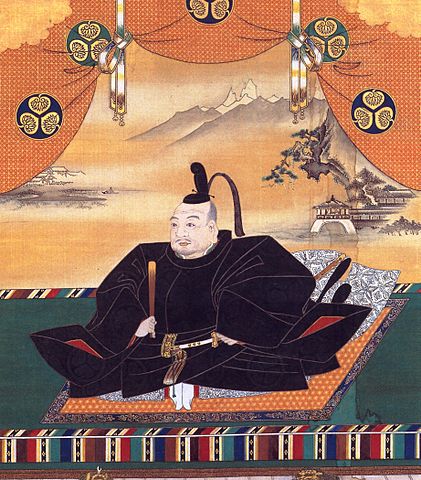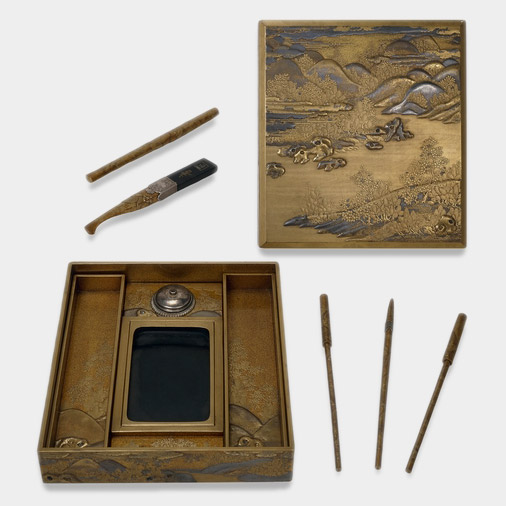
Mary Elizabeth Berry is the Class of 1944 Professor of History at the University of California, Berkeley and the first recipient of the Founders’ Fellowship at the National Humanities Center. An authority on the history of pre-modern Japan, she has been working on a project examining the remarkable changes in Japanese life that occurred in the midst of the Tokugawa shogunate (1603–1868). She sat down with us this spring to share a bit about her research.
NHC: The Tokugawa period in Japan is remarkable for many reasons but one of the most astonishing may be the incredible growth in the population of the country and the expansion of its cities.
Berry: It is astonishing, and I don’t think people put their minds around it properly. Some people think that London was the largest city in the world in the early modern period, but Edo [the pre-1868 name for Tokyo] held over a million people by 1700.
There were gigantic cities on the European continent eventually, for instance London and Paris, but they were singular giants. In Japan, though, there was Edo with over a million, along with Osaka and Kyoto, each approaching 400,000 people. And there were twenty other cities over 30,000.
NHC: One thinks of Japan as being a relatively small place.
Berry: Well, it’s about the size of California. The important thing, though, is not its size, but the amount of arable land, which is only 12 percent. At the beginning of the Tokugawa period, the population was between 12 and 15 million and by the 1700s it had more than doubled to over 30 million. So, this was a country that was far more densely populated than France, for example, which was the most densely populated country in Europe.
NHC: How did they grow enough food for all those people with such a small amount of farmable land?
Berry: Well there’s the harvest of the sea. Japan was and remains a prolific consumer of fish, sea grasses, and seaweeds, but there was also an agricultural revolution of very great importance around this time.

First of all, paddy-raised rice was Japan’s major crop and it is a perfect crop. It’s very, very hard to grow because you must have the irrigation pools, the irrigation channels; you must also plant it properly and tend it carefully. It requires pretty inspired and disciplined labor. But it is the most productive grain in the world. So small paddies can generate a great deal of nutrition. And Japan became the most efficient farming country in the world in the seventeenth century.
There was also significant reclamation of land that increased what could be farmed, much more systematic farming of what they had, and increasing use of commercial fertilizers made out of sardines. So you have incredibly fastidious farmers mastering very difficult skills for profit.
Taxes were originally very high, as much as 50 percent of the harvest, maybe higher. But after the comprehensive surveys ordered by Toyotomi Hideyoshi in the late sixteenth century, the lands were not routinely and systematically resurveyed, and new farm land — and more productive farm land — was not being registered and taxed aggressively, so there was incentive to farm brilliantly. But this was not a revolution of new machines. It was much better irrigation, much more attention to rice hybrids, of which there were hundreds, a lot of testing about how early you should transplant from nursery beds. Farmers were taking notes, and there was a great deal of agricultural knowledge shared in manuals. One was written by Miyazaki Yasusada, who traveled around thirty provinces taking notes on what he saw, then organized his book according to different crops. And his main advice to farmers was to talk to one another, keep notes, and when they found a particularly effective farm, find out why it worked.
I think one of the important things about this period is the sense that the pie could get bigger, and that if you were more prosperous, it didn’t mean I was less so.
NHC: What led to this radical growth and radical urbanization?
Berry: Well, again, this is really an amazing story. From 1467 through the 1580s, Japan was embroiled in an awful period of civil war, and by the 1580s Japan was raising the largest armies known to the contemporary world. The majority of able-bodied males age fifteen or older were being conscripted for battle, and by the late stages of this very long war there were mass causalities because of the introduction of firearms by the Portuguese.
So the warlords of the time, the successful daimyo, did this amazing thing: they chose alliance with one another in order to survive. They didn’t fight it out to the bloody, horrible end. Oda Nobunaga, whose campaigns were the fiercest in many ways in the period, exposed to his contemporaries the consequences of war as they were fighting it — the likelihood of mutual annihilation.

When Nobunaga died in 1582, the two leading contenders [to take his place] were Hideyoshi and Tokugawa Ieyasu, who would later become the founder of the peacetime shogunate. After Nobunaga died, they were involved in two major confrontations. Tokugawa Ieyasu was the victor in the first, and the probable victor in the second, when the two made peace. When I tell my students about this, they ask, “Why would Tokugawa Ieyasu do that?” Because losing would not be good, but winning would not necessarily be good, either. The winner would become the target of other would-be conquerors. And not only did they turn to what I call a federal form of alliance to save themselves — Japan was eventually divided into over two hundred individual domains in this period, each headed by daimyo — they also addressed the problem of maintaining peace throughout the country. They went at this full-bore.
The landscape was covered with petty fortifications that enabled border contests. They leveled them. They stripped agrarian communities and armed monasteries of weapons. Then there were all these samurai fighters. With their families, samurai made up something like 8 to 9 percent of the population. They took these samurai, who lived in villages with a fair amount of independence, and confined them in their own castle towns. This began a mass migration and changed Japan from an agrarian into an urbanizing world.
Kyoto, the imperial capital, had a population over 100,000 toward the end of the seventeenth century. But these castle towns were pretty rudimentary. They were not ready to supply the goods and services that the samurai migrants needed, but it worked out. It shouldn’t have.
NHC: What, then, do you think were the keys to their success?
Berry: Parts of the story scholars know a lot about. The agrarian revolution — well, really a work revolution — was crucial. The initiatives of the state were also crucial — both Toyotomi Hideyoshi and Tokugawa Ieyasu were pretty inventive redesigners of a new world — developing currency, standardizing weights and measures, building roads. The tax policies toward trade were also very, very generous. But I’m writing about what I’m calling economic culture and the spirit that inspired players of all social levels to remake their lives — to fashion a commercial market and to embrace novelty. There were deep reasons for the readiness for change, but there were also major problems to be dealt with.
There was no legal guarantee of private property, for instance, so commercial exchange, contracts, land sales — all these transactions required instruments of protection that generated trust. I’m very interested in how economic trust among traders and within the larger population developed. It was generated largely by urban commoners who developed elaborate contracts and neighborhood rules about land sales, the registration of heirs and wills, and other transactions. And neighbors had to give collective assent to these internal matters.
Another problem that’s particularly interesting has to do with consumption. This was a world in which frugality and savings were a kind of religion. You find these values everywhere in texts from the period. Yet it was also a world, particularly after major constraints were placed on foreign trade, that had to grow financially through very vigorous domestic consumption.
NHC: So how did they justify the level of consumption that took place?
Berry: Every society has what I’d call rules of consumption — the rules that legitimate or authorize or valorize buying. Nobody writes them down, but you can usually figure them out, and we all know what they are in terms of our own lives. They differ by place and period, but I put them in three categories. One is the category of utility. We can always buy — freely, happily, and virtuously — things that are useful. We give our children socks and books and learning games. The category is wonderfully expansive, of course. In Japan there was a great deal of emphasis on things like books, tools, the fertilizers that transformed agriculture. You can go on and on.
Then there’s this middle category concerned with propriety. It was appropriate for a shop owner to have a decent shop, to offer customers tobacco and tea, to have a flower display, to have proper clothing with proper crests. This is also an expansive category. There are many sumptuary laws during the period because the government wanted total correspondence between status and presentation. Samurai were a privileged elite. Commoners were not. Samurai could wear certain kinds of fabrics — the finest silks — that were theoretically forbidden to farmers. On the other hand, headmen in villages, elders in neighborhoods, were excused from the restriction because their dignity demanded silks.

Finally, there’s a vast category associated with sociability. It was important to be a gentleperson, and if you wanted to be a gentleperson, you needed to send letters, you needed to be able to compose poetry, practice the tea ceremony properly, give and exchange gifts. The cultivation of all these arts is expensive and involves a whole lot of “stuff” — for instance, calligraphy requires all the different papers, the brushes, the ink, the rests for the brushes, the weights for the paper, the carved jade signature chops, the precious old bamboo holders for brushes. Consumption in the service of sociability becomes more and more elaborate.
So, in a variety of ways, this was a society that became deliriously interested in the material world and very, very expensive things. But it also highly valued productivity and profit. The commercial ethos is pretty amazing. One thing that was included in every primer for merchants is this little saying associated with the head of the Shirokiya family, who were major cotton merchants. It became something of a mantra throughout this world: if you never sell at high profit — just modest profit — and sell good, honestly made products, you will become rich. The main thing was to make sure that shinyo, trust, was pervasive; that is, if you buy from me the thing is well made, no cut corners. You can rely on it. It’s an object of virtue.
One book of the time called the “Illustrated Encyclopedia of Humanity” lists about five hundred different employments, and in each case talks about the value of the goods people are making, how they have been crafted faithfully by real individuals with names and addresses. There was a real veneration of craft, hard work, smart work, and an understanding of the high prices excellent goods entail.
NHC: Did the rising tide of success and wealth extend throughout the society?
Berry: No. Japan has one of the most level societies in the world, in terms of income. But, no, there was the creation of an urban underclass. There were unsuccessful farmers. There was real suffering.
NHC: And what happened to those individuals? Was there a notion of social responsibility for the poor, for instance?
Berry: The most important institutions in the society were the individual blocks in the city and the corporate villages in the countryside. They were extensively self-governing, and these villages and blocks took responsibility for abandoned children, for example. Beggars were registered and authorized to collect alms in certain neighborhoods, where they then owed services such as policing and cleanup. There was an extensive organization of poverty and collective responsibility for suffering.
But there was also a lot of surveillance. As I said, the neighborhood was a pretty powerful instrument. You couldn’t buy or rent property unless the neighborhood agreed to let you. And enterprises that were noisome they tried to exclude — shamisen teachers because they made so much racket, or dealers in charcoal because the traffic was so heavy, certainly public baths because the fire to heat the water was dangerous. Once you went into a neighborhood, most major life decisions needed the approval of the community. And, at night, the gates were closed and watchmen were set. Very safe, very regulated.
This was a society that encouraged a lot of experimentation and also a lot of conformity. Remember, this was a dense, tight society that was essentially isolated from foreign encounter. The Dutch and the Chinese were trading in Nagasaki, but there was significant control on outside encounters and even imported books.
NHC: Did the growth and success of this insular society continue once encounters with the outside increased?
Berry: Sure. The economic explosion of the Meiji period, when Japan was “opened” to the international community, is a well-known story. And it owed a great deal to the Tokugawa experience — to an early modern society with a robust market economy, pervasive schooling and literacy, strong families, and exceptional cohesion.